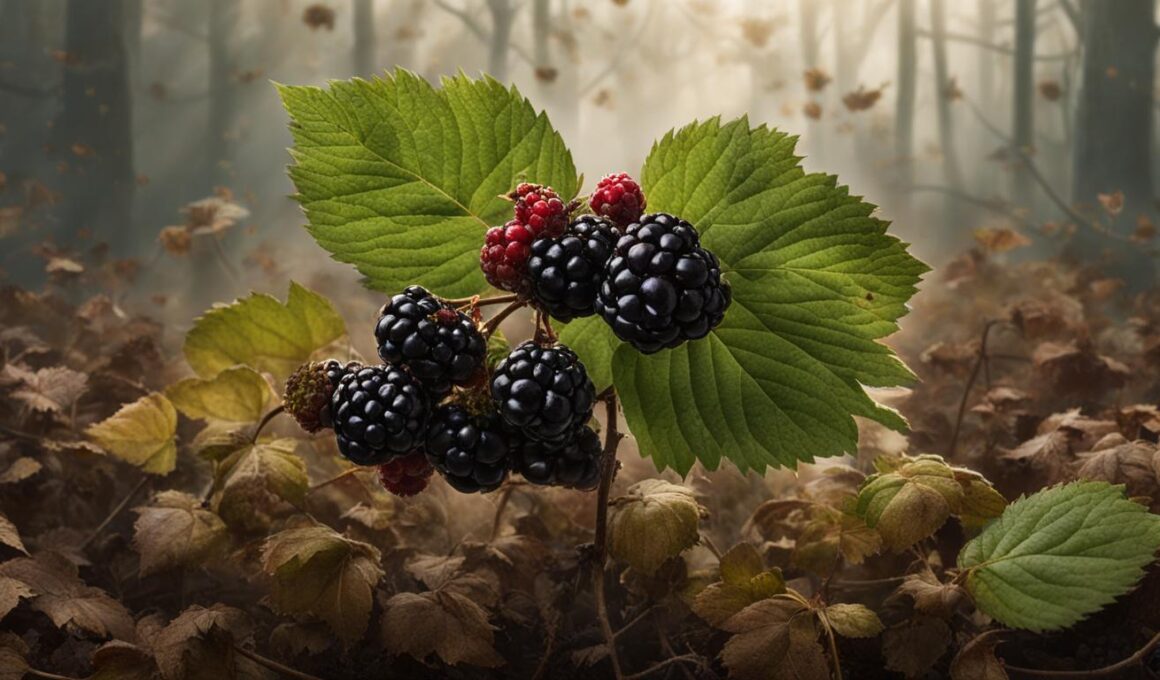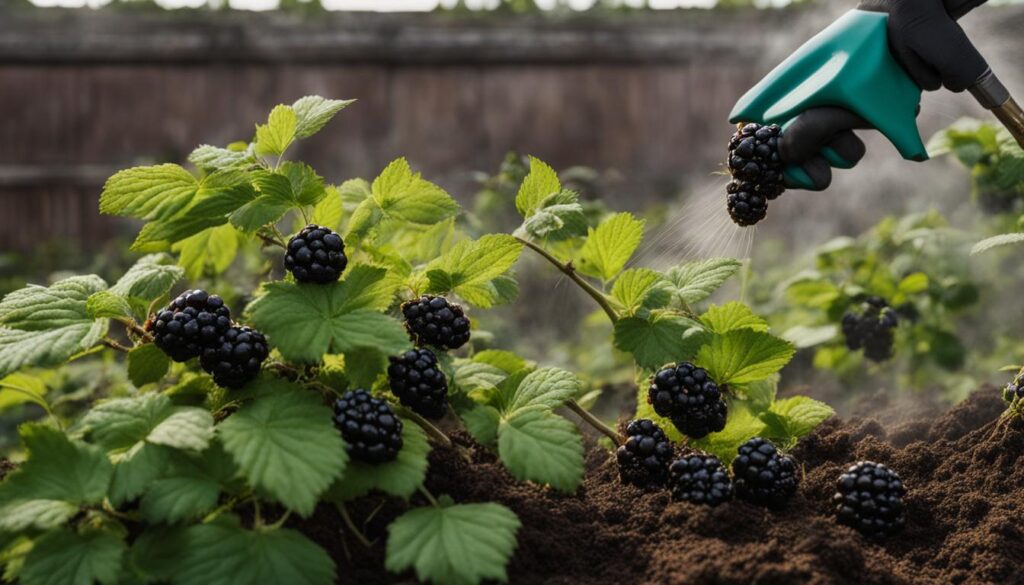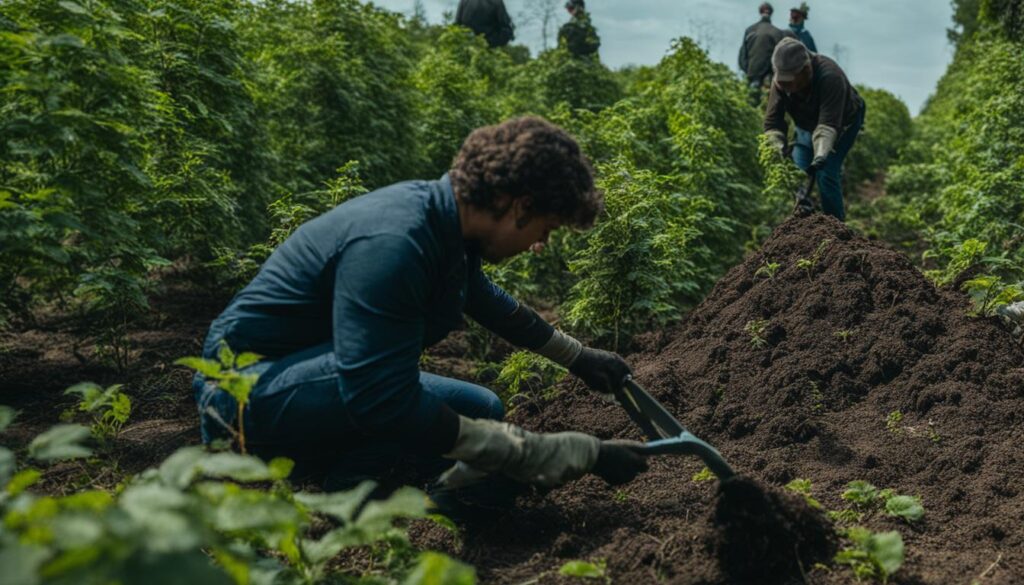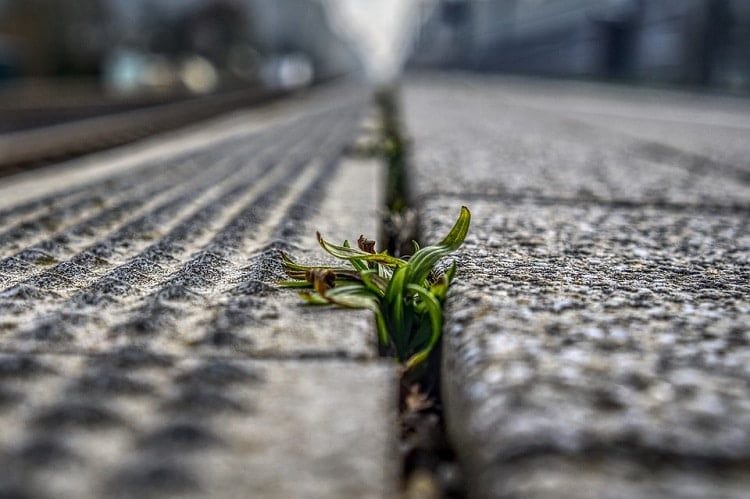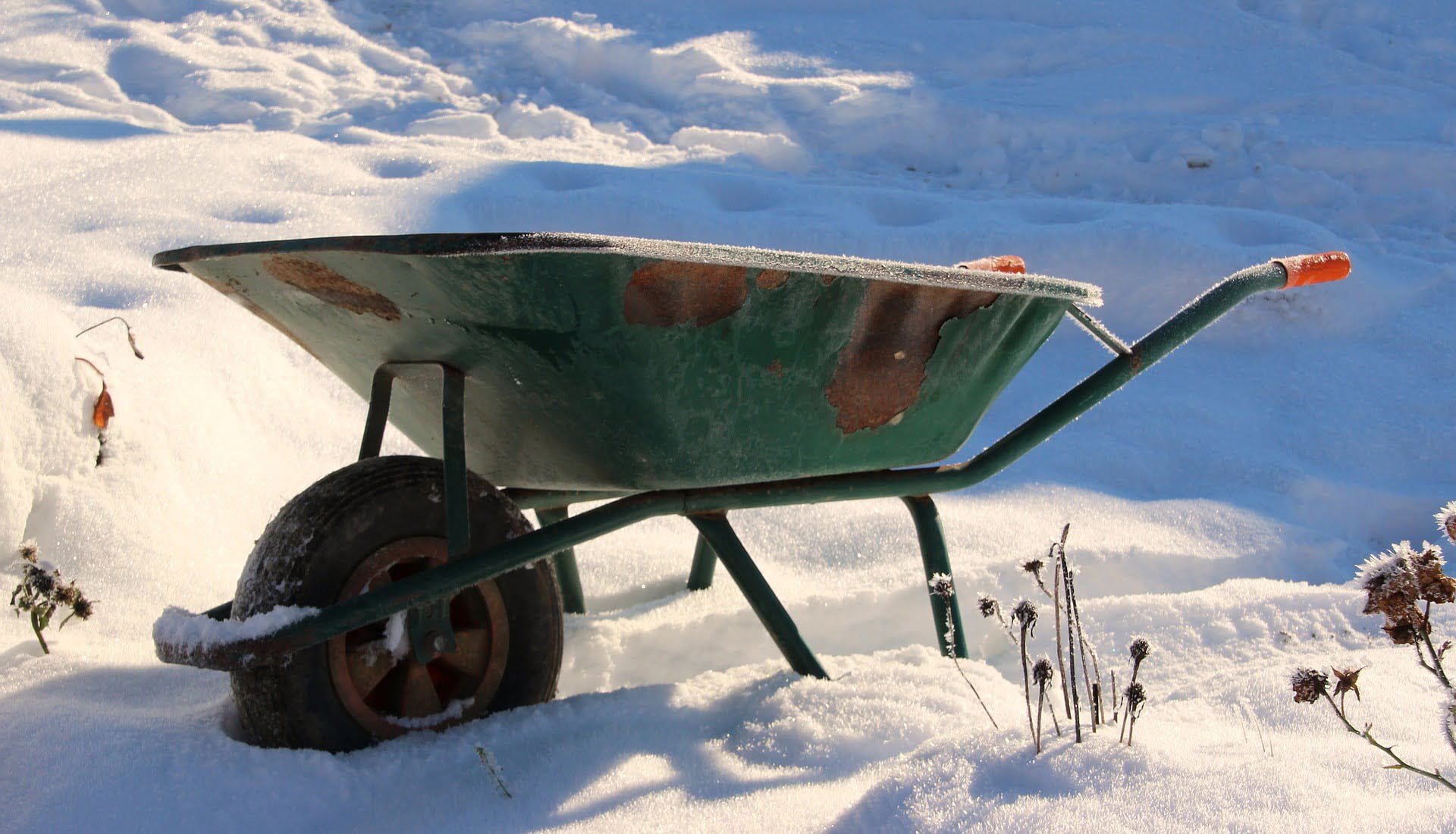Blackberry bushes, belonging to the genus Rubus and closely related to other economically important crops, can sometimes become invasive due to their aggressive and sprawling growth habit. One popular method for controlling these rapid-growing shrubs and trailing vines is through the use of Roundup, an herbicide containing the active ingredient glyphosate. This systemic herbicide is known for effectively controlling blackberry bushes by targeting their vascular system and disrupting essential growth processes. However, it is essential to consider the potential resistance and robust growth habit of blackberries to fully understand the impact of Roundup glyphosate on these plants.
Key Takeaways
- Roundup, containing the active ingredient glyphosate, is effective in controlling the growth of invasive blackberry bushes.
- Blackberries have a robust growth habit and may exhibit resistance to herbicides, making complete control a challenging process.
- The systemic action of Roundup disrupts essential growth processes within the plant, often leading to its death.
- Understanding the herbicide’s impact on blackberry bushes is crucial for proper application and management strategies.
- Roundup glyphosate can be a valuable tool in controlling invasive blackberries when used responsibly and in accordance with environmental and safety guidelines.
Identifying the Invasive Nature of Wild Blackberries
Invasive wild blackberries are a leading concern for those maintaining natural spaces and gardens. Due to their aggressive growth habit, they can quickly overtake and choke out native vegetation. In this section, we will explore the specific characteristics of the Rubus species contributing to their invasive nature and the management challenges they pose.
The Growth Habit of Wild Blackberry Species
Different wild blackberry species, such as Rubus armeniacus (Himalayan blackberry) and Rubus laciniatus (cutleaf blackberry), possess distinct growth traits that contribute to their invasive tendencies. These species feature vigorous growth, displaying evergreen longevity with vegetative canes that replace dying canes annually from the root crown. While seed dispersal does occur, primarily through animal droppings, blackberry species primarily expand through vegetative growth. The root systems and rhizomes of these blackberry bushes can cover vast areas, making their containment a significant challenge.
Why Controlling Blackberry Bushes Can Be a Challenge
The control of blackberry bushes presents several eradication difficulties. The plants showcase tenacious growth and can regenerate from the crown or rhizomes even after disturbances like mowing, hand pulling, or herbicide application such as Roundup. This persistence of the root system, along with the plant’s resprouting ability, necessitates ongoing management efforts.
Approaches to blackberry bush control can be grouped into two main categories: eradication and containment. Determining the most suitable strategy depends on factors like the scale of infestation and the desired outcome. To aid in selecting the best approach, consider the following comparison:
| Control Strategy | Advantages | Disadvantages |
|---|---|---|
| Eradication | Complete removal of the blackberry population, creating room for native plants and reducing competition for resources. | Requires intensive labor, time, and resources. May lead to ecological disturbances and increased risk of soil erosion in some cases. |
| Containment | Minimizes the negative impact of blackberries on surrounding flora by limiting their spread. Less costly and less labor-intensive. | Unlikely to eliminate the problem permanently. Ongoing management efforts required to prevent further spread. |
By understanding the growth habit and invasive characteristics of Rubus species, better management strategies can be devised to control and maintain blackberry bushes in various outdoor settings. Ultimately, the control of these plants often necessitates a tailored approach based on factors like site conditions and management goals, while acknowledging the inherent challenges that these species present.
Roundup’s Role in Weed and Brush Control
As a glyphosate-based formula, Roundup herbicide has become the go-to solution for weed and brush control. It is effective in killing a variety of vegetation types, including invasive blackberry bushes. This non-selective, systemic herbicide is absorbed through plant foliage and then transported throughout the entire plant system, including the roots, to target the enzyme crucial for plant growth. To achieve control over invasive weed species like blackberries, it is imperative to use Roundup according to the label instructions.
Roundup’s effectiveness in weed control and blackberry brush management is a result of its glyphosate-based formula. The herbicide is designed to specifically target the enzyme 5-enolpyruvylshikimate-3-phosphate synthase (EPSPS), an essential component for the synthesis of amino acids vital to plant growth. By inhibiting this enzyme, Roundup disrupts the production of amino acids within treated plants, causing them to wither and die.
- Wear appropriate personal protective equipment (PPE) such as long sleeves, gloves, and eye protection.
- Apply Roundup at the recommended rate stated on the product label.
- Direct the spray onto the foliage of blackberry bushes, ensuring thorough coverage.
- Monitor the treated area for regrowth, and reapply if necessary.
By following these steps, you can effectively manage blackberry brush infestations and restore balance to your landscape. Additionally, integrating Roundup with other control methods, such as mechanical removal, can further enhance the overall success of your blackberry management efforts.
| Advantages | Disadvantages |
|---|---|
| Effective in controlling various vegetation types, including blackberries | Potential risk to non-target plants if not used carefully |
| Non-selective, systemic herbicide ensures thorough eradication | Requires proper application for the best results |
| Can be combined with other control methods for enhanced management | May need multiple applications to ensure complete control |
To ensure continued success in controlling blackberry bushes, monitor the treated areas for regrowth. Depending on the level of infestation and specific blackberry species, multiple applications may be required to achieve lasting control. When used correctly and in combination with other management strategies, Roundup can be a valuable tool for successful blackberry brush management.
The Science Behind Glyphosate – Roundup’s Active Ingredient
Glyphosate, the active ingredient in the well-known systemic herbicide Roundup, plays a crucial role in eliminating weeds, including the invasive blackberry bushes. Understanding the science behind its mode of action is essential for both effective and responsible use of the herbicide.
How Glyphosate Works to Eliminate Weeds
Glyphosate, as a broad-spectrum herbicide, works on a cellular level to interrupt essential plant growth processes. Upon application, it penetrates the plant’s leaves and is translocated to various growth nodes through the phloem. Its primary function is to inhibit the activity of an essential enzyme, known as enolpyruvylshikimate-3-phosphate synthase (EPSPS), which is vital for plants to synthesize the necessary amino acids for growth.
- Glyphosate application to foliage
- Translocation through phloem
- Inhibition of the EPSPS enzyme
- Disruption of amino acid synthesis
- Interruption of plant growth
- Weed death
The Systemic Action of Roundup on Plant Growth
The systemic herbicide action of glyphosate ensures that the entire plant is affected by the treatment, significantly improving its efficacy in eliminating robust and invasive weeds like blackberry bushes. Systemic action involves the absorption of glyphosate through the plant’s foliage and its subsequent transportation to all parts of the plant, including the root system.
This comprehensive reach is integral for thorough control of invasive plant species, as the herbicide must come into contact with the leaves to be effective. Once applied, the systemic action of Roundup prevents further growth, spread, and reproduction of the treated plants, leading to their eventual death.
| Processes Affected by Roundup | Impact on Blackberry Bushes |
|---|---|
| Glyphosate absorption | Herbicide penetrates leaves |
| Systemic action | Glyphosate translocation to all plant parts |
| EPSPS enzyme inhibition | Amino acid synthesis disruption |
| Growth interruption | New branch and leaf development halted |
| Death of treated plants | Elimination of invasive blackberry bushes |
Pros and Cons of Using Roundup on Blackberry Bushes
While Roundup is a popular choice for blackberry control, it is essential to weigh the advantages and disadvantages associated with its use. Considerations include the environmental impact, alternative management methods, safety, and effectiveness of this herbicide. With a comprehensive understanding of the benefits and drawbacks, you can make informed decisions when attempting to manage blackberry bushes effectively.
Environmental Considerations and Alternative Control Methods
The environmental impact of Roundup bears consideration due to potential effects on non-target plants, soil health, and wildlife habitats. Though clearly a powerful herbicide for controlling blackberries, exploration of alternative control methods is warranted. These methods might include:
- Mechanical removal
- Cultivation
- Mowing
- Biocontrol
Each alternative blackberry control method has its benefits and drawbacks. For instance, mechanical removal may provide quick results but can be labor-intensive. Conversely, biocontrol methods, such as introducing insects that feed on blackberry bushes, can be more sustainable but may take longer to see results.
When deciding on a management approach, consider combining several methods to minimize environmental impact. This might entail using Roundup sparingly, in conjunction with other control measures to prevent overreliance on chemicals.
Safety and Effectiveness: What to Expect from Herbicide Treatment
When considering herbicide use considerations, it’s crucial to prioritize safety for humans, pets, and the environment, alongside the effectiveness of the treatment. The EPA has deemed glyphosate, the active ingredient in Roundup, safe when used according to label directions. However, vigilance is necessary to ensure proper application techniques and minimize risks.
Regarding herbicide effectiveness, Roundup can control blackberry bushes effectively, but the treatment expectations must be realistic. Completely eradicating blackberry bushes may require repeated applications and ongoing management efforts to prevent regrowth.
| Pros | Cons |
|---|---|
| Effective at controlling blackberry bushes | Potential environmental impact |
| Considered safe by EPA when used as directed | May require repeated applications |
| Can be complemented with alternative control methods | Risks to non-target plants and wildlife |
In conclusion, using Roundup for blackberry bush control necessitates a careful balance between safety and effectiveness. Engage in appropriate timing, application, and complementary alternative control methods to ensure optimal results while mitigating potential environmental impact.
Application Tips for Roundup on Blackberry Bushes
To achieve the best results when using Roundup on blackberry bushes, it is essential to adhere to proper application techniques and timing. Both the time of day and season during which the herbicide is applied play a significant role in its overall efficacy.
Best Time of Day and Season for Herbicide Efficacy
The optimal time for applying Roundup varies depending on climate conditions. In general, early morning or late afternoon is recommended for warm climates, while late morning through afternoon is suitable for colder areas. Application during calm and dry weather conditions ensures greater efficacy.
In addition to daily timing, the growing season is also a pivotal factor in successful outcomes. Applying Roundup during the spring and early summer months aligns with the plants’ active growth and uptake period, considerably improving the herbicide’s potency.
Important Precautions to Enhance Safety and Minimize Risks
Roundup safety precautions are fundamental in protecting both the environment and yourself. Ensure that you use proper personal protective equipment, such as long pants and sleeves, to minimize exposure risks. Additionally, adhere to all label instructions and follow these essential guidelines for safe application:
- Keep children and pets away from treated areas until the product has dried.
- Avoid applying Roundup during windy, rainy, hot, or drought-stressed conditions, as this can minimize herbicidal risks and reduce non-target vegetation damage.
By following these Roundup application tips, including optimal herbicide timing and necessary safety precautions, you can effectively eliminate invasive blackberry bushes while minimizing both environmental and personal risks.
Managing Blackberry Regrowth and Ensuring Complete Eradication
Blackberry regrowth management is crucial to keep invasive blackberry species in check after initial treatment. Preventing the reinfestation of blackberry bushes requires consistency in the application and maintenance of eradication strategies. Long-term blackberry management aims to maintain a desirable landscape while mitigating the revival and spread of blackberry plants in the area.
Strategies for Preventing Blackberry Reinfestation
Timely and repeated treatments are essential to combat regrowth and reinfestation. Several strategies can be employed:
- Mechanical controls, such as mowing or digging, can reduce canopy, but must be accompanied by herbicide applications or mulching to prevent resurgence.
- Introducing grazing animals that feed on blackberry foliage can help mitigate the vegetation’s spread.
- Revegetating the area with desirable species can outcompete blackberries and contribute to long-term control and prevention.
- Consistent monitoring of treated areas is crucial to detect and address any resurgence in a timely manner.
Long-Term Management and Maintenance of Treated Areas
Effective blackberry management encompasses not only regrowth control but also maintenance and area restoration. After blackberry bush eradication, long-term maintenance and area restoration strategies include:
- Reseeding or planting desired vegetation to deter blackberry establishment.
- Conducting regular inspections of treated areas to detect and remove any new blackberry growth.
- Applying herbicides where necessary to maintain control over invasive plants.
- Promoting native plant diversity and practicing responsible land management to ensure a healthy, balanced ecosystem.
By adhering to these best practices, you can ensure sustainable success in your blackberry eradication and management efforts, promoting a thriving, diverse landscape that remains free of invasive blackberry infestations.
Legal and Environmental Restrictions for Roundup Usage
Public and environmental safety concerns have led to specific regulation and restrictions on herbicides, including Roundup. Users are required to follow local and federal guidelines, such as those from the Environmental Protection Agency (EPA), as well as consider public sentiments and safety protocols when applying in areas frequented by people and pets. Adherence to regulations and proper usage contribute to responsible herbicide application.
Regulatory Guidelines and Public Concerns Over Herbicide Use
The regulatory guidelines for Roundup usage vary depending on the state and municipality. Some jurisdictions may have stricter limitations due to increased public safety concerns, particularly regarding the protection of water sources, wildlife habitats, or ecosystems. In addition to adhering to EPA recommendations and guidelines, it is crucial to remain up-to-date on local regulations to ensure compliance and foster public trust in the use of herbicides such as Roundup.
Understanding Tier-based Limitations for Enhanced Safety in Parks and Public Areas
Tier-based limitations govern the use of herbicides like Roundup in parks and public areas. Restrictions may include written recommendations from licensed professionals, adherence to the San Francisco Reduced Risk Pesticide List, and prohibitions of use for cosmetic purposes or within certain distances of pathways and children-frequented areas.
- Written recommendations from licensed professionals should cover the appropriate chemical concentration levels and application techniques.
- Adherence to the SF Reduced Risk Pesticide List is crucial for responsible herbicide usage in public spaces, as it guides authorities to prioritize low-risk pesticides for vegetation management.
- Prohibitions for cosmetic purposes or within certain distances of pathways and children-frequented areas are established to minimize exposure to herbicides and protect the safety of park users and the environment.
Understanding and following these tier-based limitations is essential for enhanced safety and compliance in the application of Roundup and similar herbicides. By abiding by these guidelines, park managers and homeowners alike can uphold an ethical approach to landscape management while balancing the need for effective weed control and fostering healthy ecosystems.
How Does Roundup Affect Pilea Peperomioides and other Plants?
Roundup can negatively impact Pilea Peperomioides and other plants. To ensure healthy Pilea Peperomioides solutions, it’s crucial to avoid using Roundup or any other harmful herbicides near these plants. Instead, opt for natural weed control methods to maintain a safe and thriving environment for your plants.
Conclusion
Understanding the safe and effective use of Roundup as a solution for blackberry bush control is essential not only for successful eradication but also for minimizing the environmental impact and ensuring public safety. Knowledge of the herbicide’s mechanism and the invasive nature of blackberries plays a crucial role in achieving desired results.
When using Roundup, adhering to local and federal regulatory guidelines, as well as considering responsible application techniques, is vital for preserving the environment and maintaining public trust. Alternative control methods and ongoing management strategies are also important elements to consider when working towards a balanced and desirable landscape.
In summary, responsible Roundup application and the adoption of holistic blackberry control methods can lead to effective management of invasive blackberry bushes, ultimately restoring and maintaining the health and aesthetics of the affected areas. By prioritizing safety and compliance, the use of Roundup can be a highly valuable tool for managing invasive blackberry growth.





